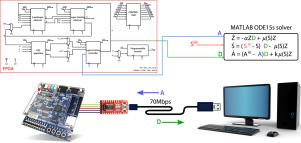在黑暗发酵过程中最大限度提高醋酸生产率的 FPGA 嵌入式优化算法
IF 3.3
2区 计算机科学
Q2 AUTOMATION & CONTROL SYSTEMS
引用次数: 0
摘要
本文介绍了一种在线最大化暗发酵(DF)工艺中醋酸盐生产率的优化策略。采用黄金分割搜索算法计算最大醋酸盐生产率,并将其作为入口化学需氧量(COD)和稀释率的函数。超级扭曲控制器将此最大生产率作为参考,以调节 DF 工艺的实际醋酸盐生产率。由于缺乏在线测量化学需氧量的传感器,优化策略包括一个未知输入观测策略,该策略由一个与超级扭转观测器相互连接的卢恩伯格观测器整合而成,用于估计入口处的化学需氧量浓度。优化算法嵌入到 FPGA(现场可编程门阵列)设备中,以最大限度地减少硬件资源和功耗。数值模拟证明了嵌入 FPGA 的在线优化策略的可行性,该策略采用定点格式表示的数字架构设计。结果表明,该优化策略只需要 FPGA Cyclone II 53% 的逻辑元件和 100% 的 8 位乘法器,功耗估计仅为 190mW。本文章由计算机程序翻译,如有差异,请以英文原文为准。

FPGA-embedded optimization algorithm to maximize the acetate productivity in a dark fermentation process
This paper presents an optimization strategy to online maximize the acetate productivity rate in a dark fermentation (DF) process. The Golden Section Search algorithm is used to compute the maximum acetate productivity rate as a function of the inlet chemical oxygen demand (COD) and the dilution rate, selected as a manipulated variable. Such maximum productivity is considered as a reference by a Super-Twisting controller to regulate the real acetate productivity rate of the DF process. Due to the lack of sensors to measure the COD online, the optimization strategy includes an unknown input observation strategy integrated by a Luenberger observer interconnected to a Super-Twisting observer to estimate the inlet COD concentration. The optimization algorithm is embedded in an FPGA (Field Programmable Gate Array) device to minimize hardware resources and power consumption. The feasibility of the online optimization strategy embedded in an FPGA, using a digital architecture designed with a fixed-point format representation, is demonstrated by numerical simulations. Results show that the optimization strategy requires 53% of the logic elements and 100% of 8-bit multipliers of an FPGA Cyclone II and the power consumption estimated is only .
求助全文
通过发布文献求助,成功后即可免费获取论文全文。
去求助
来源期刊

Journal of Process Control
工程技术-工程:化工
CiteScore
7.00
自引率
11.90%
发文量
159
审稿时长
74 days
期刊介绍:
This international journal covers the application of control theory, operations research, computer science and engineering principles to the solution of process control problems. In addition to the traditional chemical processing and manufacturing applications, the scope of process control problems involves a wide range of applications that includes energy processes, nano-technology, systems biology, bio-medical engineering, pharmaceutical processing technology, energy storage and conversion, smart grid, and data analytics among others.
Papers on the theory in these areas will also be accepted provided the theoretical contribution is aimed at the application and the development of process control techniques.
Topics covered include:
• Control applications• Process monitoring• Plant-wide control• Process control systems• Control techniques and algorithms• Process modelling and simulation• Design methods
Advanced design methods exclude well established and widely studied traditional design techniques such as PID tuning and its many variants. Applications in fields such as control of automotive engines, machinery and robotics are not deemed suitable unless a clear motivation for the relevance to process control is provided.
 求助内容:
求助内容: 应助结果提醒方式:
应助结果提醒方式:


